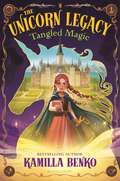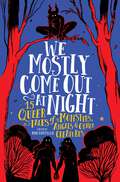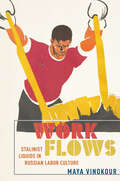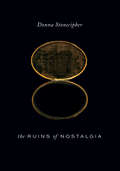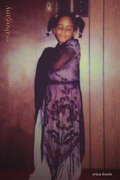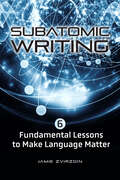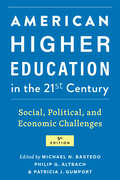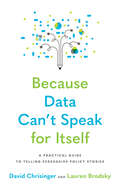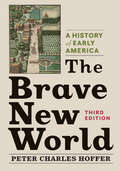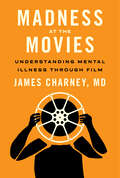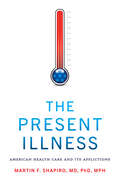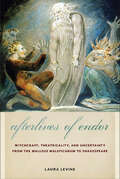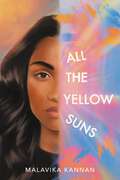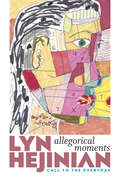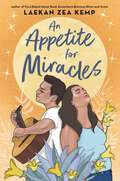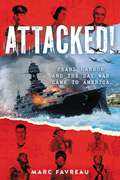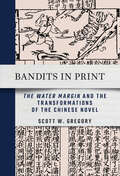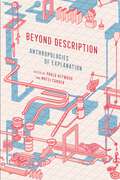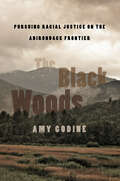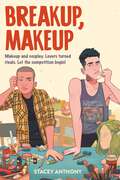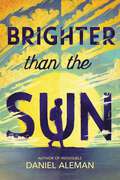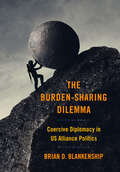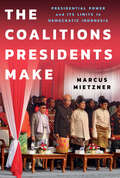- Table View
- List View
The Unicorn Legacy: Tangled Magic
by Kamilla Benko"A sparkling page-turner full of surprising twists, clever girls, and magical wonders!" -Tui Sutherland, #1 New York Times bestselling author of the Wings of Fire seriesFrom the creator of The Unicorn Quest series, a wondrous new series set in the magical land of Arden, full of unicorns and mystery!Magic pulses bright in Arden, a world where humans who craft magic have been at war and separated for hundreds of years. Now a new era has dawned, the unicorns have returned, and the prime minister has decreed that apprentices from all four guilds will learn in the newly formed Unicorn Academy. But peace is tenuous: As rumors spread of dark magic and of unicorns disappearing, twelve-year-old apprentice Olivia Hayes is caught between her joy at newfound magical abilities at the academy and proving to everyone that her older sister, Laurel, is NOT a unicorn poacher. She and her friends must untangle the truth and the secrets of the past to spin a stronger future-or else the unicorns of Arden may be lost forever. This sweeping middle grade fantasy is about friendship, choice, and the ties that truly matter.
We Mostly Come Out at Night: 15 Queer Tales of Monsters, Angels & Other Creatures
by Rob CostelloAn empowering cross-genre YA anthology that explores what it means to be a monster, exclusively highlighting trans and queer authors who offer new tales and perspectives on classic monster stories and tropes. Be not afraid! These monsters, creatures, and beasties are not what they appear. We Mostly Come Out at Night is a YA anthology that reclaims the monstrous for the LGBTQA+ community while exploring how there is freedom and power in embracing the things that make you stand out. Each story centers on both original and familiar monsters and creatures—including Mothman, Carabosse, a girl with thirteen shadows, a living house, werebeasts, gorgons, sirens, angels, and many others—and their stories of love, self-acceptance, resilience, and empowerment. This collection is a bold, transformative celebration of queerness and the creatures that (mostly) go bump in the night. Contributors include editor Rob Costello, Kalynn Bayron, David Bowles, Shae Carys, Rob Costello, H.E. Edgmon, Michael Thomas Ford, Val Howlett, Brittany Johnson, Naomi Kanakia, Claire Kann, Jonathan Lenore Kastin, Sarah Maxfield, Sam J. Miller, Alexandra Villasante, and Merc Fenn Wolfmoor.
Work Flows: Stalinist Liquids in Russian Labor Culture (NIU Series in Slavic, East European, and Eurasian Studies)
by Maya VinokourWork Flows investigates the emergence of "flow" as a crucial metaphor within Russian labor culture since 1870. Maya Vinokour frames concern with fluid channeling as immanent to vertical power structures—whether that verticality derives from the state, as in Stalin's Soviet Union and present-day Russia, or from the proliferation of corporate monopolies, as in the contemporary Anglo-American West. Originating in pre-revolutionary bio-utopianism, the Russian rhetoric of liquids and flow reached an apotheosis during Stalin's First Five-Year Plan and re-emerged in post-Soviet "managed democracy" and Western neoliberalism.The literary, philosophical, and official texts that Work Flows examines give voice to the Stalinist ambition of reforging not merely individual bodies, but space and time themselves. By mobilizing the understudied thematic of fluidity, Vinokour offers insight into the nexus of philosophy, literature, and science that underpinned Stalinism and remains influential today. Work Flows demonstrates that Stalinism is not a historical phenomenon restricted to the period 1922-1953, but a symptom of modernity as it emerged in the twentieth century. Stalinism's legacy extends far beyond the bounds of the former Soviet Union, emerging in seemingly disparate settings like post-Soviet Russia and Silicon Valley.
The Ruins of Nostalgia (Wesleyan Poetry Series)
by Donna StonecipherWhat is it to feel nostalgia, to be skeptical of it yet cleave intently to the complex truths of feeling and thought? In a series of 64 gorgeous, ramifying, unsettling prose poems addressing late-twentieth- and twenty-first century experience and its discontents, The Ruins of Nostalgia offers a strikingly original exploration of the misunderstood phenomenon of nostalgia as both feeling-state and historical phenomenon. Each poem, also titled The Ruins of Nostalgia, is a kind of lyrical mini-essay, playful, passionate, analytic. Some poems take a location, memory, conceit, or object as their theme. Throughout the series, the poems recognize and celebrate the nostalgias they ironize, which are in turn celebrated and then ironized again. Written often in the fictional persona of the first-person plural, The Ruins of Nostalgia explores the rich territory where individual response meets a collective phenomenon.[sample poem]The Ruins of Nostalgia 13Where once there had been a low-end stationery store minded by an elderly beauty queen, there was now a store for high-end espresso machines minded by nobody. Where once there had been an illegal beer garden in a weedy lot, there was now a complex of luxury lofts with Parisian-style ivory façades. Where once there had been a bookstore and a bike shop and a bakery, there was now a wax museum for tourists. Where once there had been an empty lot there was now a building. Where once there had been an empty lot there was now a building. Where once there had been an empty lot there was now a building. Where once there had been an empty lot there was now a building. Where once there had been farms there were now subdivisions. Where once there had been subdivisions there were now sub-subdivisions. We lived in a sub-subdivision of a subdivision. We ourselves had become subdivided—where once we had merely been of two minds. * Where once there had been a river there was now a road. A vocal local group had started a movement to break up the road and "daylight" the river, which still flowed, in the dark, underneath the road. * Could we daylight the farms, the empty lots, the stationery store, the elderly beauty queen, the city we moved to? Was it still flowing somewhere, under the luxury lofts, deliquescing in the dark, inhabited by our luxury selves, not yet subdivided, because not yet whole? * Could we daylight the ruins of nostalgia?
mahogany (Wesleyan Poetry Series)
by erica lewismahogany takes its name from the dark wood prized for its durability, workability, and elegant look, and from the Diana Ross movie, whose theme song asks if what lies ahead is what you really want. This book is the third in a trilogy, and like the first two books it is steeped in pop music. Each poem here takes its title from a line of a Diana Ross and The Supremes song, as well as songs from Diana Ross' solo career. Short lines flow down the page like postmodern psalms, connecting dailyness to timelessness, merging the historical and the beloved through reverence for family, music, and the life we actually live. mahogany is a lament for the passing of time and unimaginable loss, and at the same time it models the daily search for joy, and the deep shine that can arise from the darkest times.[sample poem]i'm like a woman who once knew splendor* sometimes i feel like the pink pantherall naked and pinklost in the morass ofdo the best you can todayand nigga heal thy selfour end of winterspirits breaklike old tibetan snowi rememberyou was conflictedand i found myself alonehere on my ancient hurtthe disquieting humof living historydear god, pleaseput my head above my heartwe can only be togetherif the stories are toldplain facesame instrumentjust a couple of coke bottlesfull of gasolinelike god and rainis a waste of timemy mother used to clean housesas a childsome days i can barelyget out of bedin my mindshe's like diana rossscrubbing the white lady's stairsin lady sings the bluesexcept prettierand with green eyesi've just been livingoff of cough dropsand water and angerjust sitting in the whole foodsparking lot eating pineapplei am literallythe definition of "hot mess"pain changes everythingsomebody comeand pick upmy limp bodyoff the groundi am dyinga slow ohio deathwe miss you starmanit's our first sunrise of the burn* "dark side of the world"erica lewis
Subatomic Writing: Six Fundamental Lessons to Make Language Matter
by Jamie ZvirzdinSee science writing fundamentals afresh through a subatomic lens!In Subatomic Writing, Johns Hopkins University instructor Jamie Zvirzdin goes bravely into uncharted territory by offering a totally new kind of guide for writing about science—from the subatomic level up! Subatomic Writing teaches readers that the building blocks of language are like particles in physics. These particles, combined and arranged, form something greater than their parts: all matter in the literary universe. The six levels of language covered in this guide create writing that illuminates and energizes the reader to feel, learn, change, and act. This interdisciplinary approach helps scientists, science writers, and editors improve their writing in fundamental areas as they build from the sounds in a word to the pacing of a paragraph. These areas include• Sound and sense• Word classes• Grammar and syntax• Punctuation• Rhythm and emphasis• Pacing and coherenceEqually helpful for students who need to learn how to write clearly about science and scientists who need to hone their writing skills to create more effective course material, papers, and grant applications, this guide builds confidence in writing abilities as old skills are taught in new, exciting ways. Each lesson provides exercises that build on each other, strengthening readers' capacity to communicate ideas and data, all while learning basic particle physics along the way.
American Higher Education in the Twenty-First Century: Social, Political, and Economic Challenges
by Michael N. Bastedo Philip G. Altbach Patricia J. GumportNow in its fifth edition! An indispensable reference for anyone concerned with the future of American colleges and universities.Whether it is advances in information technology, organized social movements, or racial inequality and social class stratification, higher education serves as a lens for examining significant issues within American society. First published in 1998, American Higher Education in the Twenty-First Century offers a comprehensive introduction to the complex realities of American higher education, including its history, financing, governance, and relationship with the states and federal government. This thoroughly revised edition brings the classic volume completely up to date. Each chapter has been rewritten to address major recent issues in higher education, including the COVID-19 pandemic, the movement for racial justice, and turmoil in the for-profit sector. Three entirely new chapters cover broad-access colleges, race and racism, and organized social movements. Reflecting on the implications of ethnic and socioeconomic diversity within higher education, the book also grapples with growing concerns about the responsiveness and future of the academy.No other book covers such wide-ranging issues under the broader theme of higher education's relationship to society. Highly acclaimed and incorporating cutting-edge research, American Higher Education in the Twenty-First Century is now more useful and engaging than ever.Contributors: Michael N. Bastedo, Philip G. Altbach, Patricia J. Gumport, Peter Riley Bahr, Joy Blanchard, Julia Brickfield, Michael Brown, Katherine S. Cho, Daniela Conde, Charles H. F. Davis III, Hans de Wit, Peter D. Eckel, Martin Finkelstein, Denisa Gándara, Liliana M. Garces, Roger L. Geiger, Leslie D. Gonzales, Jillian Leigh Gross, Jessica Harris, Nicholas Hillman, Julia Rose Karpicz, Robert Kelchen, Adrianna Kezar, Lisa R. Lattuca, Demetri Morgan, Rebecca Natow, Anna Neumann, Audrey Peek, Laura W. Perna, Gary Rhoades, Tykeia N. Robinson, Roman Ruiz, Wonson Ryu, Lauren T. Schudde, Jeffrey C. Sun, David A. Tandberg
Because Data Can't Speak for Itself: A Practical Guide to Telling Persuasive Policy Stories
by David Chrisinger Lauren BrodskyA guide for how to tell clear, data-driven stories that will make an impact.People with important evidence-based ideas often struggle to translate data into stories their readers can relate to and understand. And if leaders can't communicate well to their audience, they will not be able to make important changes in the world. Why do some evidence-based ideas thrive while others die? And how do we improve the chances of worthy ideas? In Because Data Can't Speak for Itself, accomplished educators and writers David Chrisinger and Lauren Brodsky tackle these questions head-on. They reveal the parts and functions of effective data-driven stories and explain myriad ways to turn your data dump into a narrative that can inform, persuade, and inspire action. Chrisinger and Brodsky show that convincing data-driven stories draw their power from the same three traits, which they call people, purpose, and persistence. Writers need to find the real people behind the numbers and share their stories. At the same time, they need to remember their own purpose and be honest about what data says—and, just as importantly, what it does not. Compelling and concise, this fast-paced tour of success stories—and several failures—includes examples on topics such as COVID-19, public diplomacy, and criminal justice. Chrisinger and Brodsky's easy-to-apply tool kit will turn anyone into an effective and persuasive evidence-based writer. Aimed at policy analysts, politicians, journalists, teachers, and business leaders, Because Data Can't Speak for Itself will transform the way you communicate ideas.
The Brave New World: A History of Early America
by Peter Charles HofferA lively synthesis of early American history, now in its third edition.The Brave New World covers the entire span of early American history, from 30,000 years before Europeans landed on North American shores to the Revolutionary War. With its exploration of the places and peoples of early America, this comprehensive new edition of a classic textbook brings together the most recent scholarship on the colonial and revolutionary eras, Native Americans, slavery and the slave trade, politics, war, and the daily lives of ordinary people.In this edition, Peter Charles Hoffer incorporates the wealth of innovative work on early American history, including fresh material on• environmental history• the Dutch and French Caribbean• Indigenous societies• consumer goods• mapping• captivity tales• settler imperialism• power—who has it, who wants it, how it is expressed, and how it is opposedEmphasizing how diverse and entangled the early American imperial world was, this edition also greatly expands the geographical scope of the book. An updated bibliographic essay offering short descriptions of relevant books, articles, collections, and anthologies rounds out the volume. Wide-ranging and inclusive, The Brave New World continues to provide students, instructors, and historians with an engaging and accessible history of early North America.
Madness at the Movies: Understanding Mental Illness through Film
by James CharneyA unique exploration of how mental illness is portrayed in classic and contemporary films.The study of classic and contemporary films can provide a powerful avenue to understand the experience of mental illness. In Madness at the Movies, James Charney, MD, a practicing psychiatrist and long-time cinephile, examines films that delve deeply into characters' inner worlds, and he analyzes moments that help define their particular mental illness. Based on the highly popular course that Charney taught at Yale University and the American University of Rome, Madness at the Movies introduces readers to films that may be new to them and encourages them to view these films in an entirely new way. Through films such as Psycho, Taxi Driver, Through a Glass Darkly, Night of the Hunter, A Woman Under the Influence, Ordinary People, and As Good As It Gets, Charney covers an array of disorders, including psychosis, paranoia, psychopathy, depression, bipolar disorder, obsessive-compulsive disorder, and anxiety. He examines how these films work to convey the essence of each illness. He also looks at how each film reflects the understanding of mental illness at the time it was released as well as the culture that shaped that understanding.Charney explains how to observe the behaviors displayed by characters in the films, paying close attention to signs of mental illness. He demonstrates that learning to read a film can be as absorbing as watching one. By viewing these films through the lens of mental health, readers can hone their observational skills and learn to assess the accuracy of depictions of mental illness in popular media.
The Present Illness: American Health Care and Its Afflictions
by Martin F. ShapiroBeyond political posturing and industry quick-fixes, why is the American health care system so difficult to reform?Health care reform efforts are difficult to achieve and have been historically undermined by their narrow scope. In The Present Illness, Martin F. Shapiro, MD, PhD, MPH, weaves together history, sociology, extensive research, and his own experiences as a physician to explore the broad range of afflictions impairing US health care and explains why we won't be able to fix the system without making significant changes across society. With a sharp eye and ready humor, Shapiro dissects the ways all groups participating—clinicians and their organizations, medical schools and their faculty, hospitals and clinical corporations, scientists and the National Institutes of Health, insurers and manufacturers, governments and their policies, and also patients and the public—shape and reinforce a dysfunctional system. Shapiro identifies three major problems stymieing reform: commodification of care; values, expectations, unmet needs, attitudes, and personal limitations of participants; and toxic relationships and communication among these groups.Shapiro lays out a sweeping agenda of concrete actions to address the many factors contributing to the system's failings. Highlighting the interconnectedness of both the problems and potential solutions, he warns that piecemeal reform efforts will continue to be undermined by those who believe they have something to gain from the status quo. Although overhauling our health care system is daunting, Shapiro nonetheless concludes that we must push forward with a far more comprehensive effort in all sectors of health care and throughout society to create a system that is humane, effective, and just.
Afterlives of Endor: Witchcraft, Theatricality, and Uncertainty from the "Malleus Maleficarum" to Shakespeare
by Laura LevineAfterlives of Endor offers an analysis of the way early modern English literature addressed the period's anxieties about witchcraft and theatricality. What determined whether or not a demonologist imagined a trial as a spectacle? What underlying epistemological constraints governed such choices and what conceptions of witchcraft did these choices reveal? Pairing readings of demonological texts with canonical plays and poetry, Laura Levine examines such questions. Through analyses of manuals and pamphlets about the prosecution of witches—including Reginald Scot's skeptical The Discoverie of Witchcraft (1584), King James VI/I's Daemonologie (1597), and Jean Bodin's De la Demonomanie des Sorciers (1580)—Afterlives of Endor examines the way literary texts such as Shakespeare's The Winter's Tale and The Tempest, Spenser's The Faerie Queene, and Marlowe's Tragicall History of Doctor Faustus address anxieties about witchcraft, illusion, and theatricality. Afterlives of Endor attends to the rhetorical tactics, argumentative investments, and underlying tensions of demonological texts with the scrutiny ordinarily reserved for literary texts.
All the Yellow Suns
by Malavika KannanA coming-of-age story about a queer Indian American girl exploring activism and identity through art, perfect for fans of Aristotle and Dante Discover the Secrets of the Universe. Sixteen-year-old Maya Krishnan is fiercely protective of her friends, immigrant community, and single mother, but she knows better than to rock the boat in her conservative Florida suburb. Her classmate Juneau Zale is the polar opposite: she&’s a wealthy white heartbreaker who won&’t think twice before capsizing that boat. When Juneau invites Maya to join the Pugilists—a secret society of artists, vandals, and mischief-makers who fight for justice at their school—Maya descends into the world of change-making and resistance. Soon, she and Juneau forge a friendship that inspires Maya to confront the challenges in her own life. But as their relationship grows romantic, painful, and twisted, Maya begins to suspect that there&’s a whole different person beneath Juneau&’s painted-on facade. Now Maya must learn to speak her truth in this mysterious, mixed-up world—even if it results in heartbreak.
Allegorical Moments: Call to the Everyday
by Lyn HejinianAllegorical Moments is a set of essays dedicated to rethinking allegory and arguing for its significance as a creative and critical response to sociopolitical, environmental, and existential turmoil affecting the contemporary world. Traditionally, allegorical interpretation was intended to express an orthodoxy and support an ideology. Hejinian attempts to liberate allegory from its dogmatic usages. Presenting modern and contemporary materials ranging from the novel to poetry to painting and cinema to activist poetry of the Occupy movement, each essay in the book "begins again" with different materials and from different perspectives. Hejinian's generative scholarship looks back to experimental modernism and forward into a future for a vital, wayward poetry resistant to the crushing global effects of neoliberalism.
American Higher Education in the Twenty-First Century: Social, Political, and Economic Challenges
by Michael N. Bastedo, Philip G. Altbach, and Patricia J. GumportNow in its fifth edition! An indispensable reference for anyone concerned with the future of American colleges and universities.Whether it is advances in information technology, organized social movements, or racial inequality and social class stratification, higher education serves as a lens for examining significant issues within American society. First published in 1998, American Higher Education in the Twenty-First Century offers a comprehensive introduction to the complex realities of American higher education, including its history, financing, governance, and relationship with the states and federal government. This thoroughly revised edition brings the classic volume completely up to date. Each chapter has been rewritten to address major recent issues in higher education, including the COVID-19 pandemic, the movement for racial justice, and turmoil in the for-profit sector. Three entirely new chapters cover broad-access colleges, race and racism, and organized social movements. Reflecting on the implications of ethnic and socioeconomic diversity within higher education, the book also grapples with growing concerns about the responsiveness and future of the academy.No other book covers such wide-ranging issues under the broader theme of higher education's relationship to society. Highly acclaimed and incorporating cutting-edge research, American Higher Education in the Twenty-First Century is now more useful and engaging than ever.Contributors: Michael N. Bastedo, Philip G. Altbach, Patricia J. Gumport, Peter Riley Bahr, Joy Blanchard, Julia Brickfield, Michael Brown, Katherine S. Cho, Daniela Conde, Charles H. F. Davis III, Hans de Wit, Peter D. Eckel, Martin Finkelstein, Denisa Gándara, Liliana M. Garces, Roger L. Geiger, Leslie D. Gonzales, Jillian Leigh Gross, Jessica Harris, Nicholas Hillman, Julia Rose Karpicz, Robert Kelchen, Adrianna Kezar, Lisa R. Lattuca, Demetri Morgan, Rebecca Natow, Anna Neumann, Audrey Peek, Laura W. Perna, Gary Rhoades, Tykeia N. Robinson, Roman Ruiz, Wonson Ryu, Lauren T. Schudde, Jeffrey C. Sun, David A. Tandberg
An Appetite for Miracles
by Laekan Zea KempAward-winning author Laekan Zea Kemp&’s heart-wrenching novel-in-verse follows two teens who must come together to heal the pain from their pasts, perfect for fans of Elizabeth Acevedo and Nicola Yoon. Danna Mendoza Villarreal&’s grandfather is slowly losing himself as his memories fade, and Danna&’s not sure her plan to help him remember through the foods he once reviewed will be enough to bring him back. Especially when her own love of food makes her complicated relationship with her mother even more difficult. Raúl Santos has been lost ever since his mother was wrongly incarcerated two years ago. Playing guitar for the elderly has been his only escape, to help them remember and him forget. But when his mom unexpectedly comes back into his life, what is he supposed to do when she isn&’t the same person who left? When Danna and Raúl meet, sparks fly immediately and they embark on a mission to heal her grandfather ... and themselves. Because healing is something best done together—even if it doesn&’t always look the way we want it to.
Attacked!: Pearl Harbor and the Day War Came to America
by Marc FavreauThe true story of Pearl Harbor as you&’ve never read it before—action-packed, informative, and told through the eyes of a diverse group of people who experienced the terror of the unprecedented attack firsthand. A single day changed the course of history: December 7, 1941. Nobody in America knew Japan&’s attack on Pearl Harbor was coming. Nobody was prepared for the aftermath. It became a defining moment from which the country never truly recovered. Perfect for fans of Steve Sheinkin and Deborah Heiligman, this unflinching narrative puts readers on the ground in Pearl Harbor through the stories of real people who experienced the attack and its aftereffects. It alternates between the sweeping views and fateful decisions of leaders such as FDR and on-the-ground accounts from soldiers and sailors of all backgrounds as well as an array of other unique participants and observers. Attacked! sheds new, compelling light onto a history we think we know, what it means to be American, and the enduring lessons from an event we never saw coming.
Bandits in Print: "The Water Margin" and the Transformations of the Chinese Novel
by Scott W. GregoryBandits in Print examines the world of print in early modern China, focusing on the classic novel The Water Margin (Shuihu zhuan). Depending on which edition a reader happened upon, The Water Margin could offer vastly different experiences, a characteristic of the early modern Chinese novel genre and the shifting print culture of the era.Scott W. Gregory argues that the traditional novel is best understood as a phenomenon of print. He traces the ways in which this particularly influential novel was adapted and altered in the early modern era as it crossed the boundaries of elite and popular, private and commercial, and civil and martial. Moving away from ultimately unanswerable questions about authorship and urtext, Gregory turns instead to the editor-publishers who shaped the novel by crafting their own print editions. By examining the novel in its various incarnations, Bandits in Print shows that print is not only a stabilizing force on literary texts; in particular circumstances and with particular genres, the print medium can be an agent of textual change.
Because Data Can't Speak for Itself: A Practical Guide to Telling Persuasive Policy Stories
by David Chrisinger Lauren BrodskyA guide for how to tell clear, data-driven stories that will make an impact.People with important evidence-based ideas often struggle to translate data into stories their readers can relate to and understand. And if leaders can't communicate well to their audience, they will not be able to make important changes in the world. Why do some evidence-based ideas thrive while others die? And how do we improve the chances of worthy ideas? In Because Data Can't Speak for Itself, accomplished educators and writers David Chrisinger and Lauren Brodsky tackle these questions head-on. They reveal the parts and functions of effective data-driven stories and explain myriad ways to turn your data dump into a narrative that can inform, persuade, and inspire action. Chrisinger and Brodsky show that convincing data-driven stories draw their power from the same three traits, which they call people, purpose, and persistence. Writers need to find the real people behind the numbers and share their stories. At the same time, they need to remember their own purpose and be honest about what data says—and, just as importantly, what it does not. Compelling and concise, this fast-paced tour of success stories—and several failures—includes examples on topics such as COVID-19, public diplomacy, and criminal justice. Chrisinger and Brodsky's easy-to-apply tool kit will turn anyone into an effective and persuasive evidence-based writer. Aimed at policy analysts, politicians, journalists, teachers, and business leaders, Because Data Can't Speak for Itself will transform the way you communicate ideas.
Beyond Description: Anthropologies of Explanation
by Paolo Heywood and Matei CandeaBeyond Description brings anthropologists and other social scientists together to examine the problem of explanation. What is "an explanation?" What can it add? What makes it authoritative, clarifying, or misleading? Whom does it serve and how is it produced? These questions lie at the heart of recent public crises of confidence in expertise, political representation, and classic liberal visions of whom we can rely on for true and trustworthy accounts. In a world beset by events and processes that seem to defy expert predictions of their impossibility, and in which post-hoc accounts can often feel more like rationalizations than explanations, competing voices vie for public presence and seek to silence one another. Anthropology and the social sciences face such questions too, making contemporary explanatory practice both an empirical and a reflexive challenge. By combining ethnographic studies of practices of explanation in a range of contemporary political, medical, artistic, religious, and bureaucratic settings, the essays in Beyond Description offer critical examinations of changing norms and forms of explanation in the world and within anthropology itself.
The Black Woods: Pursuing Racial Justice on the Adirondack Frontier
by Amy GodineThe Black Woods chronicles the history of Black pioneers in New York's northern wilderness. From the late 1840s into the 1860s, they migrated to the Adirondacks to build farms and to vote. On their new-worked land, they could meet the $250 property requirement New York's constitution imposed on Black voters in 1821, and claim the rights of citizenship. Three thousand Black New Yorkers were gifted with 120,000 acres of Adirondack land by Gerrit Smith, an upstate abolitionist and heir to an immense land fortune. Smith's suffrage-seeking plan was endorsed by Frederick Douglass and most leading Black abolitionists. The antislavery reformer John Brown was such an advocate that in 1849 he moved his family to Timbuctoo, a new Black Adirondack settlement in the woods. Smith's plan was prescient, anticipating Black suffrage reform, affirmative action, environmental distributive justice, and community-based racial equity more than a century before these were points of public policy. But when the response to Smith's offer fell radically short of his high hopes, Smith's zeal cooled. Timbuctoo, Freemen's Home, Blacksville and other settlements were forgotten. History would marginalize this Black community for 150 years. In The Black Woods, Amy Godine recovers a robust history of Black pioneers who carved from the wilderness a future for their families and their civic rights. Her immersive story returns the Black pioneers and their descendants to their rightful place at the center of this history. With stirring accounts of racial justice, and no shortage of heroes, The Black Woods amplifies the unique significance of the Adirondacks in the American imagination.
Breakup, Makeup
by Stacey AnthonyIn this sweet and stylish romance, two lovers turned cosplay rivals go head-to-head for a chance at their dream school . . . and maybe a second chance at love. Eli Peterson is a self-taught, up-and-coming makeup artist in the cosplay scene who is barely making ends meet. While they might be slaying it with their breathtaking looks, they&’re also trying to save enough money for top surgery and convince their parents that their artistic dream is worthwhile. During a convention, Eli hears about Makeup Wars, a competition that could change everything . . . The grand prize? A scholarship to Beyond, the best SFX school on the West Coast. The problem? Going head-to-head with the most talented up-and-coming makeup artists in the scene—including rival influencer Zachary Miller, their ex-boyfriend. Eli will have to juggle their makeup brushes, their rekindled feelings for Zach, and their self-doubt in order to win everything they&’ve ever wanted: a chance to chase their dream and a second chance at love.
Brighter Than the Sun
by Daniel AlemanThis timely and thought-provoking story about a teen girl shouldering impossibly large responsibilities and ultimately learning that she doesn&’t have to do it alone is the perfect follow-up to Daniel Aleman's award-winning debut novel, Indivisible. Every morning, sixteen-year-old Sol wakes up at the break of dawn in her hometown of Tijuana, Mexico and makes the trip across the border to go to school in the United States. Though the commute is exhausting, this is the best way to achieve her dream: becoming the first person in her family to go to college. When her family&’s restaurant starts struggling, Sol must find a part-time job in San Diego to help her dad put food on the table and pay the bills. But her complicated school and work schedules on the US side of the border mean moving in with her best friend and leaving her family behind. With her life divided by an international border, Sol must come to terms with the loneliness she hides, the pressure she feels to succeed for her family, and the fact that the future she once dreamt of is starting to seem unattainable. Mostly, she&’ll have to grapple with a secret she&’s kept even from herself: that maybe she&’s relieved to have escaped her difficult home life, and a part of her may never want to return.
The Burden-Sharing Dilemma: Coercive Diplomacy in US Alliance Politics (Cornell Studies in Security Affairs)
by Brian D. BlankenshipThe Burden-Sharing Dilemma examines the conditions under which the United States is willing and able to pressure its allies to assume more responsibility for their own defense. The United States has a mixed track record of encouraging allied burden-sharing—while it has succeeded or failed in some cases, it has declined to do so at all in others. This variation, Brian D. Blankenship argues, is because the United States tailors its burden-sharing pressure in accordance with two competing priorities: conserving its own resources and preserving influence in its alliances. Although burden-sharing enables great power patrons like the United States to lower alliance costs, it also empowers allies to resist patron influence. Blankenship identifies three factors that determine the severity of this burden-sharing dilemma and how it is managed: the latent military power of allies, the shared external threat environment, and the level of a patron's resource constraints. Through case studies of US alliances formed during the Cold War, he shows that a patron can mitigate the dilemma by combining assurances of protection with threats of abandonment and by exercising discretion in its burden-sharing pressure. Blankenship's findings dismantle assumptions that burden-sharing is always desirable but difficult to obtain. Patrons, as the book reveals, can in fact be reluctant to seek burden-sharing, and attempts to pass defense costs to allies can often be successful. At a time when skepticism of alliance benefits remains high and global power shifts threaten longstanding pacts, The Burden-Sharing Dilemma recalls and reconceives the value of burden-sharing and alliances.
The Coalitions Presidents Make: Presidential Power and Its Limits in Democratic Indonesia (Cornell Modern Indonesia Project)
by Marcus MietznerIn The Coalitions Presidents Make, Marcus Mietzner explains how Indonesia has turned its volatile post-authoritarian presidential system into one of the world's most stable. He argues that since 2004, Indonesian presidents have deployed nuanced strategies of coalition building to consolidate their authority and these coalitions are responsible for the regime stability in place today. In building coalitions, Indonesian presidents have looked beyond parties and parliament—the traditional partners of presidents in most other countries. In Indonesia, actors such as the military, the police, the bureaucracy, local governments, oligarchs, and Muslim groups are integrated into presidential coalitions by giving them the same status as parties and parliament. But while this inclusiveness has made Indonesia's presidential system extraordinarily durable, it has also caused democratic decline. In order to secure the stability of their coalitions, presidents must observe the vested interests of each member when making policy decisions. The Coalitions Presidents Make details the process through which presidents balance their own powers and interests with those of their partners, encouraging patronage-oriented collaboration and disincentivizing confrontation.
